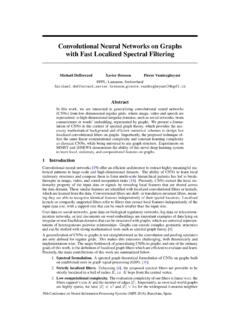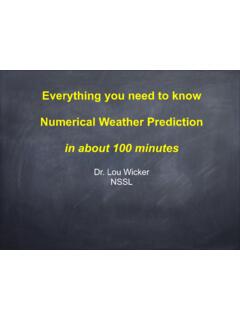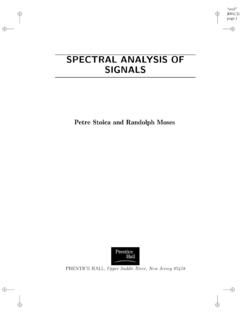Transcription of Group Velocity and Phase Velocity - San Jose State University
1 Document Velocity and Phase VelocityTuesday, 10/31/2006 Physics 158 Peter OutlineMeanings of wave velocityGroup VelocityPhase VelocityFourier AnalysisSpectral densityPower SpectrumSpectral VelocityFor a sinusoidal wave, or a waveform comprised of many sinusoidal components that all propagate at the same Velocity , the waveform will move at the Phase Velocity of the sinusoidal componentsWe ve seen already that the Phase Velocity is vp= /kWhat happens if the different components of the wave have different Phase velocities ( because of dispersion)? and Group Velocity4No dispersion (vp=vg)Dispersion (vp vg)E1E2E1+E2E1E2E1+ VelocityWhen the various frequency components of a waveform have different Phase velocities, the Phase Velocity of the waveform is an average of these velocities (the Phase Velocity of the carrier wave), but the waveform itself moves at a different speed than the underlying carrier wave called the Group vs Phase velocityAn analogy that may be useful for understanding the difference comes from velodrome cycling.
2 6 Riders race as a team and take turns as leader with the old leader peeling away and going to the back of the packAs riders make their way from the rear of the pack to the front they are moving faster than the Group that they are VelocityThe Phase Velocity of a wave is and comes from the change in the position of the wavefronts as a function of timeThe waveform moves at a rate that depends on the relative position of the component wavefronts as a function of time. This is the Group Velocity and iswhich can be found if you have"""""""""giving7v= kvg=d dk =vk=cn(k)kvg=v(1 kndndk) LightHow slow can light be made to go?In a Bose-Einstein Condensate light tuned to the atomic resonance tremendous dispersion and has been slowed to a speed Hau, et al. Light speed reduction to 17 metres per second in an ultracold atomic gas , Nature 397, 594 - 598 (18 February 1999)!
3 (")n(")normal dispersionnormal dispersionnormal dispersionnormal dispersionanomalous the dispersion equationwhere fj is the fraction of electrons that have a resonant frequency of 0j, find the Phase Velocity and Group Velocity of high frequency electromagnetic waves ( >> oj)9n2( )=1+Ne2"0me j(fj 20j 2) Phase Velocity is v=c/n so10n2( )=1+Ne2"0me j(fj 20j 2)The Group Velocity can be found fromvg=d dkv=c 1+Ne2!0me j(fj 20j 2) c(1+Ne22!0me 2) ( )=1+Ne2"0me j(fj 20j 2)vg=d dk jfj=1using""""""andk=n ck=n c c(1 Ne22"0me 2)dkd =n c (1c+Ne22"0me 2)c=d dk=c1+Ne2/2me"0 LightThe difference between Group Velocity and Phase Velocity is most relevant for light that is modulated at high frequencies or for pulses of that is modulated is by definition non-sinusoidal, however it can be thought of as the sum of many sinusoidal components consider, consider the Fourier TransformsWhen adding up the fields from an infinite number of monochromatic waves we can describe the field as an amplitude as a function of time (or space), or we can describe it by the amplitude and frequency (or wave-vector) of the waves that were added to produce function E( ) is called the Fourier Transform of E(t)13E(t)= E( )ei td TransformsE( )can be found from E(t) as follows.
4 14multiply both sides by e-i t and integrate over all timeThe oscillating function ei( - )t integrates to zero unless = so the integral is a delta function ( - ) E( )= E(t)e i tdt e i tE(t)dt= ( ) E( )ei( )td e i tE(t)dt= E( ) e i tE(t)dt= E( )ei( )td dt e i tE(t)dt= e i t E( )ei td dtE(t)= E( )ei td simplify the right hand DensityIn mathematics E( ) is called the Fourier transform of the function E(t)A more physical interpretation comes from calling it the spectral density of the electric fieldConsider the unitsE(t) V/mE( ) (V/m) s (V/m)/Hz15 E( )= E(t)e i tdtE(t)t E( ) Density16E(t)t E( )E(t)t E( )E(t)t E( )E(t)t E( ) SpectrumA plot of the spectral density shows the amplitude of the electric field as a function of frequency. It is often useful to consider the irradiance of a wave as a function of frequency, this is given by the power spectral density, aka the power spectrum of a light source.
5 17 P( )= E( ) 2spectral power distribution - HeNe laserspectral power distribution - 3400k Blackbody laserPrism SpectrometerPrinciple: incident light is refracted by a dispersive prism. The angle of refraction is a function of the wavelength and can me Components: Input slit to constrain the spatial width of the image Lenses to image the slit at the output and fully illuminate the prism Dispersive prismInstrumental Properties:SpeedSpectral TransmissionResolving Power18 spectral Resolving PowerSpectral Resolving Power - the ability to resolve spectral features (it is the inverse of the spectral resolution)Using the Rayleigh Criterion two (diffraction limited)lines are just resolvable if the peak of one line coincides with the first minimum of another diffraction pattern of a uniformly illuminated aperture of width a is which after being imaged by a lens of focal length f2 has a width from the central max to the first minimum of19 L=2L+ Lsin( (t))Lty (t)It( L/ )Scanning Confocal Fabry-PerotA Fabry-Perot is used as a wavelength selective filterMirrors of the cavity are confocal R1=R1=L so that transmitted intensity I(t) is only a function of L(t)/ (and does not depend on transverse modes in cavity produced by poor alignment)
6 One mirror is scanned back and forth to dither the length by up to a full free spectral rangeTransmission of cavity is plotted versus cavity length (on an oscilloscope) to see the spectrum of the input lightMost useful for CW sources when all of the power in the spectrum is within one free spectral range of the center wavelengthsaw tooth function generatorCalibrated by relating the time to scan through one free spectral range, to the known free spectral range of the instrument based on its wavefronts of a wave propagate at the Phase Velocity v= /kThe waveform of a wave propagates at the Group Velocity vg=d /dkIn dispersive media v vgWaveforms can be deconstructed into sinusoidal components through Fourier analysis to obtain the spectral density and power spectrum21

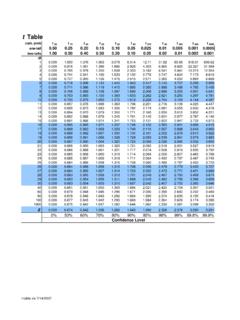
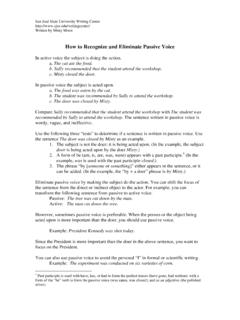
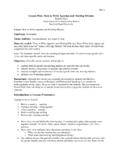




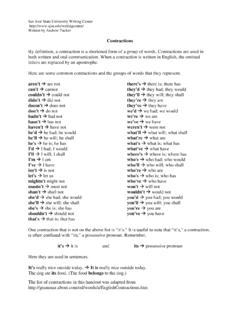
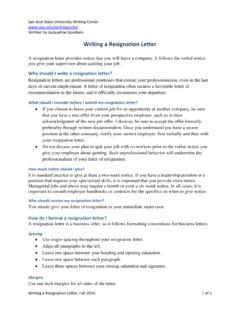

![arXiv:1801.07455v2 [cs.CV] 25 Jan 2018](/cache/preview/c/1/f/1/b/a/a/5/thumb-c1f1baa5f6e090b207f4f18380d23ecd.jpg)
